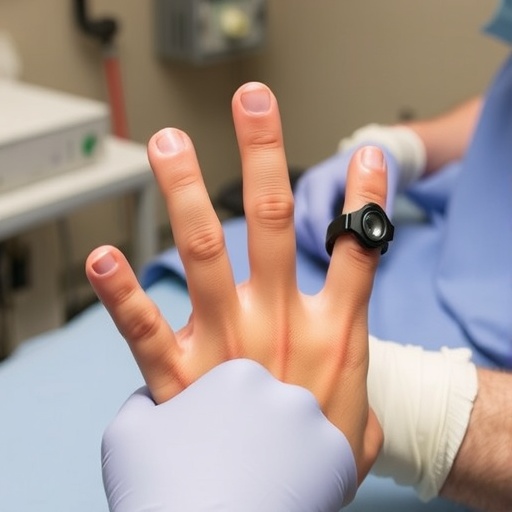In a groundbreaking development poised to shift paradigms in reconstructive surgery, a new study published in the leading journal Plastic and Reconstructive Surgery reveals that toe transfer surgery can significantly outperform traditional finger replantation in restoring hand function after digital amputations. This revelation comes from a comprehensive analysis conducted by Dr. Fu-Chan Wei of Chang Gung Memorial Hospital in Taipei, Taiwan, and his colleague Dr. Steven Lo from the Canniesburn Plastic Surgery Unit in Glasgow, Scotland. Their work challenges the long-standing convention that regards emergency replantation as the unchallenged gold standard treatment for amputated fingers and thumbs.
Finger and thumb amputations constitute a major clinical challenge, affecting approximately 45,000 individuals annually in the United States alone. These injuries often result in prolonged disability, especially when the thumb—a critical digit for hand dexterity and grip—is lost. Typically, surgeons attempt immediate replantation to salvage the severed digit. However, this approach is not always feasible or successful due to factors such as the extent of tissue damage, ischemic time, and patient-specific variables. Toe transfer surgery, whereby one or more toes are transplanted to replace the lost digits, offers an enticing alternative that has been underexplored despite its potential.
Dr. Wei and Dr. Lo’s study is remarkable not only for its size—with 126 toe transfer procedures evaluated alongside 96 finger replantations—but also for its methodological rigor and long-term focus. The investigators assessed outcomes in patients treated at Dr. Wei’s hospital, with follow-ups extending to at least five years post-surgery. By utilizing the validated Michigan Hand Questionnaire, a widely respected tool for measuring hand function, the study quantified the functional recovery in a way few prior analyses have done. The results showed that individuals undergoing toe transfers scored dramatically higher in hand function compared to those receiving replantation, with differences exceeding three times the minimum threshold for clinical significance.
An intriguing finding from this research is the amplified benefit of toe transfer surgery in patients with more severe digital injuries. Greater injury severity correlated with larger functional improvements after toe transplantation, suggesting that this technique may be especially advantageous in complex cases. This challenges the one-size-fits-all approach currently prevalent in trauma surgery and prompts a reconsideration of treatment algorithms that favor immediate replantation without exploring alternative options.
Quality of life metrics further endorse the superiority of toe transfers. Patients reported better physical health-related quality of life outcomes based on the SF-36 assessment, a comprehensive survey evaluating general health parameters. Notably, the impact on the donor site—the foot—was minimal. Postoperative foot function in patients who underwent toe transfer was comparable to the general population, dispelling concerns about potential morbidity or functional deficits caused by harvesting toes for reconstruction.
Beyond patient-reported outcomes, the researchers delved into the specific physiological and sensory factors contributing to enhanced hand function after toe transfer surgery. They identified key predictors, including increased hand range of motion, improved tripod pinch strength (a three-finger grip essential for tasks like writing), and refined moving two-point discrimination sensitivity, which measures nerve regeneration and tactile perception. These factors collectively underscore the comprehensive restoration of hand anatomy and neuromuscular control achievable with toe transfer surgery.
Historically, toe transfer surgery has enjoyed high success rates regarding surgical viability and anatomical integration. Still, it lacked robust validation through standardized functional and quality-of-life assessments until now. The absence of evidence-based guidelines to assist clinicians in selecting between replantation and toe transfer has long hindered broader adoption of the latter in clinical practice. The current study fills this critical gap, offering reliable data to inform surgical decision-making and patient consultations.
The implications of these findings extend beyond individual patient care. The authors highlight the potential for integrating toe transfer procedures into national healthcare frameworks to address digital amputations as a significant global source of disability. Given the high incidence of these injuries worldwide, widespread adoption of toe transfer interventions could revolutionize reconstructive options and functional outcomes for millions.
In light of this evidence, Drs. Wei and Lo urge a reassessment of current emergency surgical protocols for digit amputations. While immediate replantation remains an important tool, it should no longer be viewed as the exclusive or default approach. Taking toe transfer surgery into account expands the reconstructive arsenal and offers a tailored, potentially superior alternative for suitable patients.
This landmark study represents one of the largest datasets of validated patient-reported outcomes following toe transfers to date. It pioneers a nuanced understanding of functional recovery after digit loss, emphasizing that advanced microsurgical techniques can restore not just appearance, but meaningful hand utility and quality of life. As surgical innovations continue, integrating these findings into clinical guidelines promises to enhance both the science and art of hand reconstruction.
For surgeons, patients, and healthcare systems, the message is clear: toe transfer surgery should be elevated from an experimental or rarely considered procedure to a mainstream, evidence-supported reconstructive option. Future research will undoubtedly explore optimizing surgical techniques, rehabilitation protocols, and patient selection criteria to maximize the benefits elucidated in this study.
In summary, this research marks a pivotal transition in the management of digit amputations, positioning toe transfer surgery not merely as an alternative but frequently a superior modality to traditional replantation. With long-term functional restoration demonstrated through rigorous, patient-centered metrics, the reconstructive surgery community is poised to embrace a new standard that better serves those impacted by the loss of fingers and thumbs.
Subject of Research: functional outcomes of toe transfer surgery versus finger replantation after digit amputations
Article Title: Toe Transfers Outperform Replantation after Digit Amputations: Outcomes of 126 Toe Transfers
News Publication Date: August 7, 2025
Web References:
- https://journals.lww.com/plasreconsurg/fulltext/2025/08000/toe_transfers_outperform_replantation_after_digit.17.aspx
- http://journals.lww.com/plasreconsurg/
Keywords: hand function, digital amputation, toe transfer surgery, finger replantation, microsurgery, reconstructive surgery, patient-reported outcomes, hand rehabilitation, quality of life, nerve sensation, hand biomechanics, physical health




